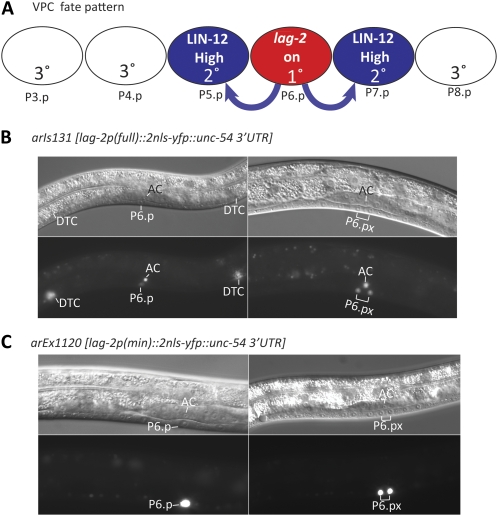Figure 1 .
VPC fate pattern and lag-2 expression. (A) Schematic view of VPC patterning. The inductive signal from anchor cell (AC) of the gonad activates the EGFR/Ras/MAPK cascade in P6.p in the early L3 stage to promote the 1° fate and lateral signal gene transcription. The lateral signal activates LIN-12/Notch to promote the 2° fate in P5.p and P7.p. Descendants of 1° and 2° cells form the vulva. VPCs that adopt the 3° fate generate two daughters that fuse with the major hypodermal syncytium, hyp7, but initially have the potential to adopt vulval fates if the EGFR or LIN-12/Notch is ectopically activated. (B) arIs131[lag-2p::2nls-yfp::unc-54 3′UTR], generated from the full-length lag-2p::2nls-yfp reporter used for deletion analysis (see Figure 2A), is expressed in P6.p, the AC, and the distal tip cells (DTCs), consistent with known functional roles for lag-2. Expression in the VPCs is restricted to P6.p and its descendants. We note that we did not observe the weak initial expression reported in all six VPCs by Chen and Greenwald (2004); we have not systematically assessed the numerous differences between the way transgenes were marked, generated, maintained, or visualized. All of the reporters presented in this study were made using similar conditions and therefore are directly comparable to each other. Furthermore, reporters in both studies behave identically for observations relating to vulval induction: both are strongly expressed in P6.p and depend on sur-2 for expression upon vulval induction. (C) arEx1120 [lag-2p(min)::2nls-yfp::unc-54] minimal reporter (Figure 2G) confers expression in P6.p and its descendants, but lacks expression in the AC and DTCs.

